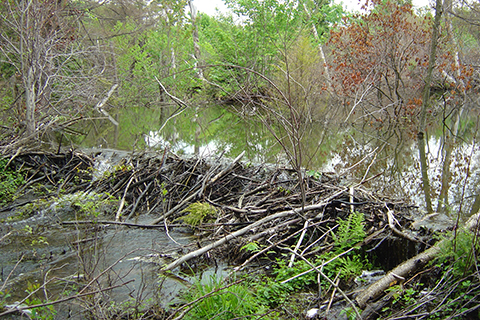Beaver dams create fascinating conditions on the landscape. In general, beaver dams are relatively small and ephemeral since the beavers leave after they exhaust accessible food in an area.
These dams often provide many unique benefits to the ecosystem. Beaver dams provide excellent and under-represented wetland habitat that benefits wetland plants, reptiles, wetland birds, amphibians, waterfowl, muskrat, mink, and the beaver themselves.

The impounded water also benefits the local floodplain hydrology by reconnecting streams to floodplains, raising water-tables, and increasing the residence time of water within the watershed.
Beaver activity can also reduce erosion, trap sediment, fix incised streams, and the wetlands can transform nitrogen and remove it from the water.
What’s the Impact on Fish?

Many people are concerned about the impacts of beaver dams on stream fish such as trout.
Beavers and trout have coexisted for long before we came to this country. In short, beaver dams do not kill trout.
Research has proven that beaver dams do not typically block fish passage. Even though these impoundments may result in elevated stream temperatures at the surface of the pond, these temperatures are not usually above the lethal threshold, and areas of cold water can still be found.
Fish can swim through the impoundments and sections with higher water temperatures to reach colder water.
The ponds are also very high in productivity, resulting in available food, high metabolism, and large fish inhabiting the ponds.
Fish are ectothermic (cold-blooded), which means they must move to warmer water to boost their immune system (fibril response), like a slight fever helping to fight an infection. These ponds provide warmer water where ailing fish can recover.
What Happens After Beavers Leave?

When the beavers abandon their dams, they usually fail resulting in a stream and a wet meadow. This wet meadow then undergoes succession to a valuable scrub-shrub wetland and often back to a forest over time.
These seral stages are beneficial to many species of wildlife such as woodcock.
Beavers are often underappreciated “nature’s engineers” that provide many benefits to the entire ecosystem.

Simple practices can help beaver out. Aspen stands within 300 feet of streams can be regenerated to provide a food source and willow can be planted along streams in openings with ample sunlight.
Providing aquatic organism passage at stream crossings is also important for allowing beaver movement without having to leave the stream and cross the road.